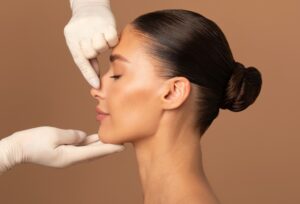Breast Reduction
Large breasts can cause major problems, both physically and psychologically. Dealing with a large excess of breast tissue often creates physical and mental burdens, such as pain, postural problems, labored breathing, body aches, breast crease irritation, and difficulty exercising, among other symptoms. It’s also not uncommon for patients with excessive breasts to be subjected to stares, rude comments, and unwelcome attention.
More often than not, oversized or pendulous breasts tend to dominate a woman’s appearance and can make her look disproportionately top-heavy — even overweight in some cases. Plastic surgeon Scott Miller, MD performs breast reduction to reshape large breasts and achieve a naturally beautiful result that is more proportionate to a patient’s body frame. For good candidates, the procedure can be one of the most rewarding cosmetic surgeries to undergo. Women enjoy an enhanced quality of life after the physical stressors and strains of overly large breasts are diminished through breast reduction.
“My whole experience with Dr. Miller and his staff has been wonderful. I have felt so well taken care of every step of the way and I love my results!”
Explore Topics On This Page
- What is Breast Reduction?
- Breast Reduction Key Terms
- Breast Reduction Candidates
- Breast Reduction Benefits
- Breast Reduction vs. Breast Lift
- Breast Reduction Incisions
- Breast Reduction Procedure
- Breast Reduction Recovery
- Breast Reduction Results
- Breast Reduction Cost
- Breast Reduction Scars
- Breast Reduction and Breastfeeding
- Non-Surgical Breast Reduction
- Male Breast Reduction
- Choosing a Top Breast Surgeon
- Breast Reduction FAQs
Key Breast Reduction Terms to Know
Educating yourself on the cosmetic procedure(s) you’re interested in can lead to greater satisfaction during and after the treatment process. At Miller Cosmetic Surgery, our team is committed to providing relevant patient education and have provided a brief guide to help you familiarize yourself with the most common terms related to breast reduction:
- : The medical name for the breast reduction procedure, which involves removing excess skin and tissue to achieve a more proportionate bust size.
- : Your skin’s ability to “bounce back” after being stretched due to pregnancy, weight gain, aging, or other factors.
- : “Pendulousness” describes a hanging or loose aesthetic, similar to breast ptosis — a condition in which the breasts sag from weakened support.
- “Shoulder-grooving”: Deep and/or painful bra strap indentations caused by large, heavy breasts.
- Areolas: The darker or pigmented tissue surrounding the nipple. An adjunctive effect of large breasts is often stretched, elongated, or disproportionate areolas.
We encourage you to contact our team if you have a question about a term you’re unfamiliar with, or about the breast reduction process in general. Dr. Miller aims to help ensure you have an informed and comprehensive understanding of the procedure.
Who is a Candidate for Breast Reduction?
Good candidates for breast reduction include patients with hanging or pendulous breasts. If the nipples and areolas point downward or exist below the breast crease, this can also be an indication for breast reduction. In general, potential candidates for surgery should:
- Wish to improve the cosmetic and/or physical issues caused by excessive breasts
- Be relatively healthy with no uncontrolled medical conditions
- Have realistic expectations about the outcome of surgery
- Quit smoking at least six weeks before the procedure
If the functional or aesthetic concerns caused by large breasts are disrupting your life, Dr. Miller would be happy to meet with you and talk about your goals during a consultation.
What are the Benefits of Breast Reduction?
On top of enhancing your silhouette and providing a more youthful, proportionate look in the bust, breast reduction improves the hardships caused by large and heavy breasts. An oversized/stretched areola can also be made smaller while the breast is reshaped to a more aesthetically pleasing contour. Breast reduction generally:
- Creates more proportionate breasts in relation to your figure
- Improves or eliminates the symptoms of large breasts
- Achieves more symmetrical, shapely, and youthful breasts
- Elevates the nipples and areolas
A breast reduction also provides some of the benefits of a breast lift to a certain degree. The final outcome of breast reduction can be long-lasting, but the breasts may still fluctuate in size afterwards with increases in weight gain, use of birth control pills, or pregnancy. Depending on your unique needs, the surgery may impair the ability to breastfeed. Dr. Miller will discuss the risks pertinent to your procedure at the time of consultation.
Breast Reduction vs. Breast Lift
Breast reduction and breast lift surgery both reshape the breasts, sometimes causing confusion for patients who may want to enhance their breasts, but are unsure which procedure would best address their needs. A personal consultation is the best way to determine the most optimal treatment option to improve your concerns. However, if your primary motivation for surgery is to obtain a lighter, smaller, or more comfortable breast size — whether for aesthetic or functional reasons — breast reduction may be the most ideal procedure for you. On the other hand, those who simply want their breasts to look tighter, lifted and more rejuvenated may benefit more from mastopexy. A breast lift (mastopexy) treats the skin only, while breast reductions treat skin and breast tissue.
Incision Options for Breast Reduction
The procedure can be performed using a few different techniques depending on the size of your breasts and the extent of “reduction” necessary to achieve your goals. Through an incision determined prior to surgery, Dr. Miller can remove excess fat, glandular tissue, and skin, leaving behind a more comfortable breast size. Options for your breast reduction incisions include:
- Circumareolar “O”: This incision pattern follows the natural change in pigmentation along the border of the areolas, allowing scars to be well-hidden once incisions are healed. While this technique offers the least amount of visible scarring, it’s only suitable when the degree of breast reduction required is minimal.
- Keyhole-Shaped: In some cases, breast reduction is performed through an incision pattern resembling a keyhole, which combines the circumareolar shape with a vertical incision. Scars after surgery are also minimal with this technique and easily concealed underneath a bra.
- Anchor-Shaped: This is the most common type of incision used during breast reduction and offers the most precise sizing and shaping of the breasts. The anchor-shaped technique involves a “lollipop” pattern around the areola with an additional horizontal incision along the breast crease. The length of the horizontal scar is proportional to the degree of reduction desired.
All incisions made during breast reduction are often well-camouflaged underneath clothing and can lighten over time. In general, either the anchor-shaped or keyhole-shaped incision is utilized to reduce larger/more pendulous breasts. Each patient will ultimately be evaluated based on their individual needs.
How is the Breast Reduction Procedure Performed?
The procedure typically takes three to four hours to perform depending on the complexity of your treatment plan. To firm and shape the breasts, excess tissue, fat, and skin are removed and redraped through incisions made horizontally and vertically along the natural contour of the breast. The nipples and areolas, which are attached to the underlying tissue, are moved to a higher, more aesthetic location. Incisions are closed with sutures, and patients are typically able to begin recovering from the comfort of their own surroundings. An overnight stay is usually not required.
What is Breast Reduction Recovery Like?
After surgery, post-operative dressings usually consist of gauze and a surgical bra. These will help to minimize the normal swelling that occurs after the procedure. Medication can control any discomfort, and patients are typically up and walking around after a day or two. As healing progresses, swelling, bruising, and tenderness will subside and most individuals can make a full return to work in about one to two weeks. However, strenuous activity should be avoided for approximately six weeks, or until cleared by Dr. Miller. You will be provided with detailed post-operative instructions regarding wound care measures, activity instructions, signs of potential complication, and more. Dr. Miller and his nursing staff will monitor your progress in periodic follow-up appointments to ensure you’re healing properly. The final outcome should be fully revealed within six months of your procedure, at which point you’ll be able to enjoy participating in activities that may have previously proved difficult with overly large breasts.
How Long Do the Results of Breast Reduction Last?
Breast reduction provides lifetime results, allowing patients to enjoy their lighter, more comfortable breast size for decades. Certain factors — including pregnancy, weight gain, and the natural aging process — can affect the contours of the breasts, but the overall aesthetic and health-related benefits of breast reduction often last indefinitely. For this reason, breast reduction patients typically consider the procedure life-changing. To maximize the longevity of your surgical results, Dr. Miller recommends practicing a healthy lifestyle and maintaining a stable weight. Most patients find it much easier to be active without having to contend with the weight of their excessive breast size.
How Much Does Breast Reduction Cost?
The factors that typically determine the price of breast reduction include the complexity of the procedure, the amount of reduction necessary, and the extent of your concerns. After Dr. Miller evaluates your concerns, our patient care coordinator will give you a personalized quote of your procedure, which will include fees for the surgical facility, anesthesia, post-operative care, and other related expenses.
In the effort to make cosmetic surgery an affordable option for all who desire it, our practice accepts plastic surgery financing from CareCredit®, one of the most popular healthcare lending companies in the country. CareCredit® offers approved patients a variety of low- to no-interest payment plans to choose from, allowing qualified applicants to pay for their breast reduction in smaller installments over a period of time. If you would like to learn more about the price of breast surgery, a member of our team would be happy to answer all of your questions. Please don’t hesitate to contact Miller Cosmetic Surgery today for more information.
Will I Have Breast Reduction Scars?
Scars may remain visible for six months to a year, but continue to fade over time. Dr. Miller is meticulous about incision placement and takes every measure to minimize post-surgical scarring for a naturally beautiful result. If your breast size was only moderately reduced, the scar should blend into the borders of the areola. An additional vertical incision may be placed depending on your needs, resulting in a small scar that extends downward towards the breast crease. For other patients, the scar may appear in an anchor-like fashion around the areola and discreetly along the natural contour of the breast fold. Dr. Miller will let you know what you can expect with regard to scarring when he sees you in a consultation.
Can I Breastfeed After Breast Reduction?
Certain techniques may be employed to increase the chances of preserving nursing function after breast reduction. However, the likelihood of breastfeeding after surgery generally depends on the approach necessary to achieve your aesthetic goals. Many women who receive a breast reduction still retain the ability to breastfeed after surgery, but we generally recommend that patients wait until any future plans for pregnancy and nursing are complete before undergoing a breast reduction. From a cosmetic standpoint, breastfeeding can cause additional skin laxity and volume loss, making the breasts more pendulous than desired. With that said, breastfeeding may technically still be possible depending on how the nipple was repositioned and/or resized, as well as whether the nerves and milk ducts were affected during surgery. Always discuss your desire for future breastfeeding with Dr. Miller so he can tailor the procedure to your unique needs.
“More than pleased! Dr. Miller takes the time to explain the treatment or procedure and answer all questions ensuring you are prepared and comfortable. Most importantly he is extremely experienced and skilled providing an excellent outcome. His staff are friendly and accommodating and I couldn’t be happier with my results.”
Is a Breast Reduction Without Surgery Possible?
Although some “breast reduction exercises” claim to naturally decrease the breast size through chest-targeted workouts, these actions merely strengthen the pectoral muscles and are often ineffective in alleviating the physical symptoms of large, pendulous breasts. Even if weight loss is achieved, a surgical breast reduction is the only technique to attain a lighter, more aesthetic breast shape proportional to your body frame. There is currently no non-surgical alternative that accurately replicates the quality of results provided by breast reduction, as the procedure is designed to create a more comfortable breast size by removing excess skin and breast tissue—an objective that is impossible to achieve without surgery.
Male Breast Reduction to Treat Gynecomastia
Overdeveloped breast tissue in men is relatively common and referred to as “gynecomastia” — a condition that is considered medically harmless, but often causes embarrassment, low self-esteem, and a negative self-image due to the visibility of male breasts. While many men are affected by gynecomastia, it sometimes resolves during puberty as the hormones stabilize. However, gynecomastia that does not self-correct during adolescence typically does not go away on its own. Dr. Miller understands that men with gynecomastia often struggle with feelings of depression, self-consciousness, and may even situations that require them to remove their shirt. At our practice in San Diego, Dr. Miller performs male breast reduction with an emphasis on achieving results that look masculine and natural. He can permanently treat your gynecomastia and restore flatter chest contours, helping you reclaim your confidence. Dr. Miller would be happy to speak with you about the procedure and the most ideal techniques for your unique situation during a consultation.
Choosing a Top Breast Reduction Surgeon in San Diego
While considered one of the most rewarding and life-changing procedures in cosmetic surgery, making the decision to undergo breast reduction can be intimidating. In general, your checklist for choosing a well-qualified and experienced breast reduction surgeon should include:
- Board certification from the American Board of Plastic Surgery, the only licensing board that can provide accreditation for aesthetic plastic surgeons
- Fellowship-training in aesthetic surgery
- A robust educational background
- Membership to local and national professional organizations, such as the American Society of Plastic Surgeons (ASPS) and the American Society for Aesthetic Plastic Surgery (ASAPS)
- A good reputation within the community and positive online reviews
- A before-and-after photo gallery showing multiple examples of a surgeon’s work
Dr. Scott Miller is one of few plastic surgeons in the country who has completed a prestigious fellowship program in aesthetic procedures. Through an in-depth consultation, Dr. Miller is able to truly understand a patient’s needs and can personalize techniques to achieve their goals accordingly.
Additional Breast Reduction FAQs
Will my insurance cover breast reduction?
Unlike other cosmetic surgeries, some of the costs associated with breast reduction may be covered by insurance if the procedure is being performed for medical reasons. Our office does not accept any insurance. For qualified patients, our practice also accepts outside financing from CareCredit® for all out-of-pocket expenses.
Does a breast reduction also provide a breast lift?
Due to the removal of redundant skin and breast tissue, a breast reduction does lift and rejuvenate the breasts. That said, if you are happy with your breast size and simply wish to resolve sagging, a breast lift alone may be a better treatment choice for your needs. Dr. Miller can help you assess all of your options after listening to your goals in a consultation.
How painful is breast reduction?
Most patients report mild to moderate discomfort rather than pain after breast reduction surgery. This is to be expected as your body begins the healing process, and over-the-counter medication can help manage swelling and other symptoms experienced during the initial stages of recovery. With plenty of rest, you should feel stronger a few days after your procedure.
How can I reduce swelling after breast reduction?
Swelling after breast reduction is normal, and usually managed well with medication and rest. Wearing the surgical bra provided after your procedure can further minimize swelling and facilitate the healing process. Limiting your diet to healthy greens, fruit, vegetables, proteins, and antioxidant-rich foods has also been known to help during recovery. It is not uncommon for residual swelling to last as long as a few months after surgery.
When can I wear a bra after breast reduction?
Patients can start wearing a non-underwire bra approximately six weeks after their breast reduction, or whenever Dr. Miller confirms it’s safe to resume doing so. Underwire bras should be avoided for at least three months.
What is macromastia?
Macromastia is the medical term for large breasts, sometimes referred to as “breast hypertrophy.” When disproportionately large breasts cause issues like back pain, reduced capacity for exercise, shoulder grooving, and skin irritation, the condition is characterized as symptomatic macromastia. Although non-surgical therapies such as anti-inflammatory medications and prescription skin creams have previously been utilized to improve the symptoms of macromastia, these solutions have proven to be temporary and exhibit a low success rate compared to surgery. Breast reduction is considered the gold standard of treating symptomatic macromastia and alleviating the physical strains caused by a large breast size.
How old do you have to be to get a breast reduction?
Breast reduction is one of the few cosmetic surgeries that can be performed on younger patients who struggle with severe symptoms caused by their large breasts, such as back pain, headaches, numbness in the upper extremities, rashes, and a lower quality of life due to their inability to exercise. In general, candidacy for breast reduction is based on factors like a patient’s physical and psychological maturity, their health, and their potential to benefit after the procedure rather than an arbitrary age threshold. Ultimately, each patient interested in breast reduction will be personally evaluated to assess their candidacy and determine the best timing for their procedure.
What are the most common breast reduction complications?
The risks of breast reduction are consistent with the potential complications that exist with any breast surgery, such as the chance of infection, negative reactions to anesthesia, irregularities in the shape or contour of the breasts, and a loss of sensation, among other unfavorable outcomes. Dr. Miller will further discuss the possible limitations and complications associated with breast reduction during your consultation. While there is no treatment or procedure that is completely risk-free, choosing a board-certified plastic surgeon who has specialized experience in aesthetic breast surgery can be the most effective way to maximize your safety.
Can you lose weight from breast reduction?
Breast reduction often encourages weight loss after the procedure because patients generally do not struggle with the same restricted mobility they may have had to endure before the procedure. As a result, many individuals who undergo breast reduction are able to become more healthy and physically active without the back pain, skin chafing, numbness, and other limitations caused by an excessive breast size.
It’s important to note that although breast reduction can make the breasts less heavy and pendulous, most patients typically lose less than five pounds during surgery. That said, it’s common for patients to look like they have lost weight after breast reduction since the procedure achieves a more balanced, proportional breast shape in relation to the rest of the body.
Can breast reduction have any health benefits?
Yes, women who receive breast reduction commonly experience an array of benefits to their health and well-being after they no longer have to contend with the weight of large, heavy breasts. In addition to reduced (or even eliminated) back and shoulder pain, some patients also experience improved posture as a result of their procedure. The ability to exercise more freely and comfortably can also lead to weight loss in the months following surgery, along with reduced stress and a more positive body image. All of these factors can significantly improve one’s mental, physical, and emotional health.









